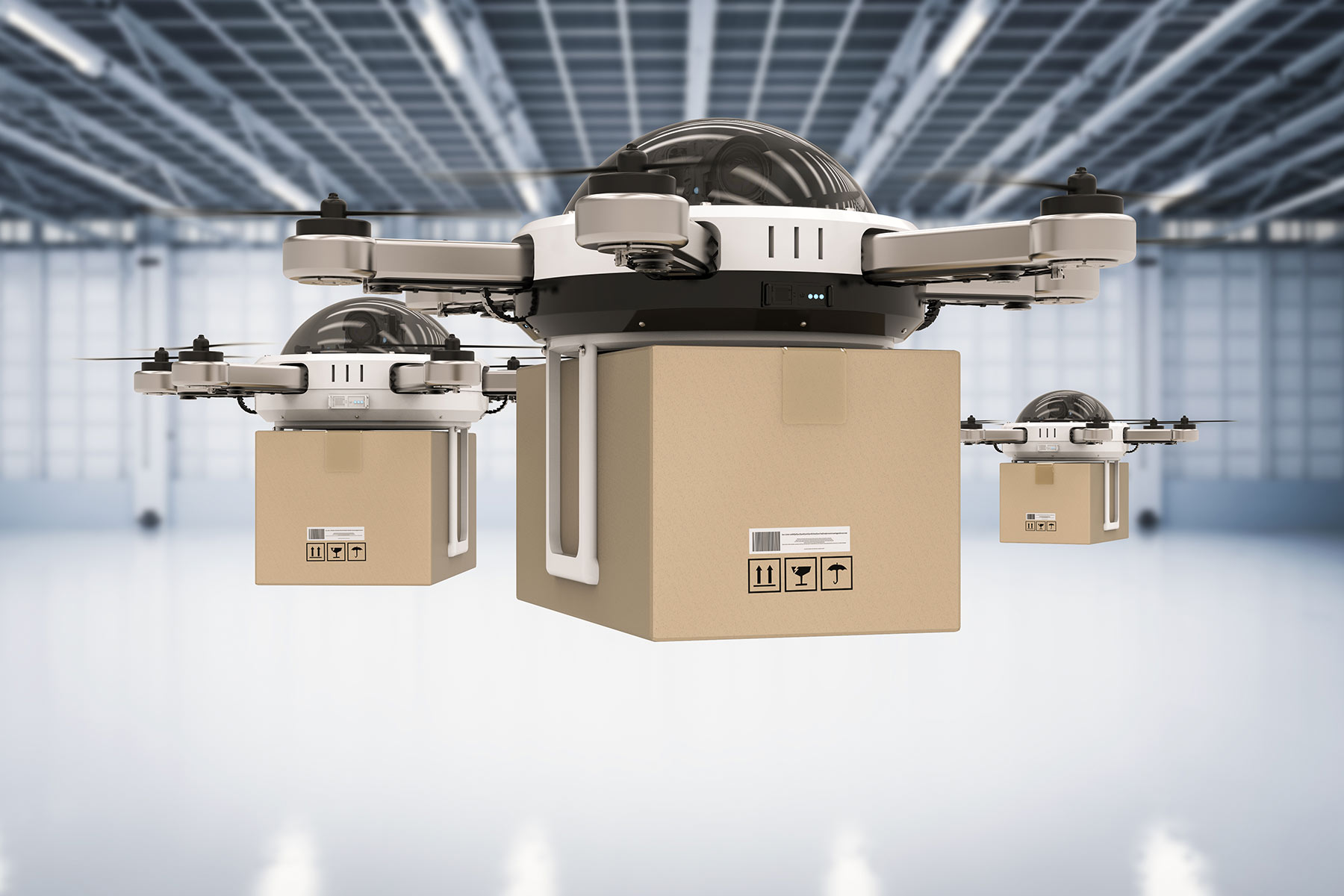December 2 of last year was an inauspicious anniversary for Jeff Bezos, the Amazon CEO who otherwise has been America’s most successful entrepreneur of the last quarter century. The world’s richest person promised in a 2013 interview on 60 Minutes that within five years, his business would be delivering customer orders with unmanned aircraft colloquially known as “drones.”
If that didn’t set Dallas-Fort Worth hearts beating fast enough, in April 2017, ride-hailing giant Uber Technologies revealed plans to start local testing of “sky cabs” by 2020, followed by a commercial launch three years later. This past January, one of Uber’s partners, Fort Worth-based Bell Helicopter, unveiled full-scale designs of its Nexus air taxi, along with a product family of drones. “We are very excited about this change in the way we move about our cities,” says Scott Drennan, Bell’s vice president of innovation.
Alas, Bezos’ self-imposed deadline came and went without large-scale drone deliveries in the U.S. because of a thicket of technical and regulatory issues that stand between our country and wider corporate use of the devices within our borders. Untangling them will likely take years, as they involve multiple federal agencies (NASA, the Federal Aviation Administration, and Department of Transportation) and creation of an air traffic control system to prevent accidents.
North Texas’ wait will probably be longer still, as Austin in 2017 passed one of the nation’s most restrictive state laws that, while aimed at protecting privacy, sharply limits municipalities’ ability to regulate drone use. A vision of what this could mean here emerged when well-intentioned drone users filled Houston’s skies with the devices after Hurricane Harvey flooded that region in 2017. “It was a nightmare for the FAA and the city as we had so many rescue helicopters going back and forth,” says Judith El Masri, an attorney at Randle Law Office who represents city governments. “The FAA regional counsel described the air above us as ‘cowboy country.’”
Under an agreement announced last year, NASA is using Uber’s data about its planned uberAIR taxis to create simulations of small, passenger-carrying aircraft as they fly at peak times through DFW’s crowded airspace. Working out of a facility at Dallas-Fort Worth International Airport, NASA officials are using the results to find safety issues as it builds prototype technology for the air traffic system, called Unmanned Aircraft System Traffic Management, or UTM for short. Uber in turn is using the agency’s simulations to plan how it will manage its flying taxis, as Scientific American has noted.
At an unspecified point this year, NASA is supposed to hand off its research results from UTM development to the FAA, which eventually will have the unenviable task of launching and running a system it didn’t build, along with making it work with its air traffic system for human-piloted aircraft. (The UTM at least aims to keep drones flying safely without humans monitoring all of them.)
Although it’s up to the feds to make all this work, the North Central Texas Council of Governments is offering our region to agencies like NASA as testing grounds for the UTM, according to Ernest Huffman, the agency’s principal transportation planner and aviation team manager. The group also is angling to get DFW a role in an event NASA will hold next year to test how next-wave flying machines and air-traffic management systems perform in urban areas. NASA last year announced the event, called the Urban Air Mobility Grand Challenge.
NCTCOG wants DFW to play a part in solving issues of keeping drones safe and integrating air traffic systems that manage both manned and unmanned flights, according to Huffman, who heads up an NCTCOG task force tackling them. “When a solution is discovered, we also want North Texas to be optimized for those operations and, later, the business opportunities from this emerging industry,” he says.
Regulatory Complexities
In addition to technical issues, federal regulators face a likely multi-year job of creating rules for everything from certifying drones for safety to governing the noise they can make. For now, local companies face tight federal restrictions while they experiment with ways to use the gadgets to cut costs and increase revenue.
Perhaps the biggest issue is that the craft must stay in their operators’ “line of sight” when airborne. The law Gov. Greg Abbott signed in 2017 adds more complexity. After a drone in 2011 detected pig blood in a Dallas creek located near a slaughterhouse, the new law criminalized flying them over “critical infrastructure” facilities, including “concentrated animal feeding operations.” That’s atop a 2013 law that makes it a Class C misdemeanor to fly them over private property “with the intent to conduct surveillance.”
El Masri, the Houston attorney, believes the answer will come when large companies lobby the FAA to create one set of rules that they must follow everywhere. “The state of Texas has nearly taken complete control of regulating drones but for federal laws and FAA regulations,” she says.
Bell is working with government agencies like the FAA and other partners so certification and regulation requirements allow for commercialization in the mid 2020s of an “urban air mobility network,” says Drennan. For instance, the company is helping NASA on a systems-integration project to manage low-altitude flight in communities and national airspace. “Current aviation safety requirements should be met,” Drennan says, “but new vehicles and operational models may mitigate risks in different ways.”
On the other side of things, the absence of an air traffic control system for drones may help fuel research and development, according to Adam Rehm, a Dallas-based shareholder at Polsinelli. “There has been a lot of press surrounding danger posed by drones, especially to commercial aircraft,” he says. “As such, we’ve seen an uptick in patent filings for technology directed to bringing down drones and preventing them from entering restricted airspace or being hacked to take control of them.”
Slurpees From the Sky
In 2014, Lakemaid Beer began using drones to deliver 12-packs to thirsty ice fishermen in Minnesota and Wisconsin—until it was grounded by the FAA. Two years later, Irving-based 7-Eleven made what it claimed was the first commercial drone delivery to a home, in a Nevada test flight with donuts and Slurpees as reported cargo. The company pulled off the haul more than four months before Amazon, which opted to do its initial delivery in England.
DFW Airport, meanwhile, was one of three sites where American Airlines tested drones for inspecting its planes, along with Phoenix and Tulsa, Oklahoma. “We chose those locations because we have IT team members and aircraft maintenance technicians at those facilities interested in exploring drone technology,” says Phil Easter, director of emerging technologies. “We have no immediate plans to begin using those craft as part of our maintenance operations.”
Other local businesses are poised to gain extraordinary efficiencies from drones, once the government settles on the rules for using them. The devices have already delivered more accurate inspections and better work coordination on more than 75 buildings Dallas-based Beck Group has put up, from Mary Kay’s manufacturing facility in Lewisville to the JPMorgan Chase campus in Plano, according to Grant Hagan, virtual design and construction manager. “Drones prevent accidents on job sites because a team member no longer has to scale a roof or access a problematic area,” he says. “Drones do that now.”
The devices have the potential to have a profound impact on day-to-day operations, Hagan adds. “It’s rare to have a technology in construction be cost-effective, safe, and time-efficient to the point where it’s improving processes,” he says. “Typically, you only get to pick two of the three options when evaluating tools. But with drones, we get all three.”
Going forward, construction firms and other businesses will likely find ways to derive value from them. “The sky and our imagination are genuinely the limit to how we use this technology,” Hagan says. “It’s exciting to put them to use.”
Jeff Bounds is an award-winning business writer based in Garland.






